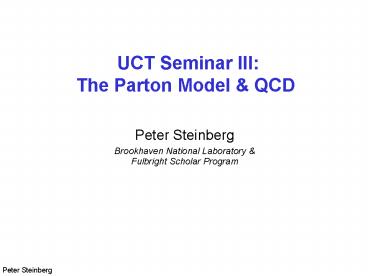UCT Seminar III: The Parton Model PowerPoint PPT Presentation
1 / 26
Title: UCT Seminar III: The Parton Model
1
UCT Seminar IIIThe Parton Model QCD
- Peter Steinberg
- Brookhaven National Laboratory
- Fulbright Scholar Program
2
Outline
- What is a proton?
- Quark model
- Probing a proton
- Deep-inelastic scattering
- DIS observations
- Scaling at x.3
- Scaling violations
- QCD in DIS
- DGLAP evolution
- Splitting functions
- PDFs
- Gluon structure function
- Extraction
- Available sets
- Applications
- Cross sections of hard processes
- Heavy flavor
- Drell-yan
- Limits to pQCD approach
- Total cross section
- Nuclear effects
- EMC Effect
- Shadowing
- Parton Saturation
- Fragmentation functions
- Evolution eqns
3
Studying Proton Structure
- At low energies, study elastic scattering
- Non-relativistic Quantum Mechanics
- Rutherford static, spinless
- Mott electron has spin
- Form factors
- Relativistic Quantum Mechanics
- Rosenbluth Formula
- Measurements of proton
4
Whats a Proton?
n
- We have heard that a proton is a set of three
quarks bound strongly by gluons - How do we know this?
- Can we ask more quantitative questions?
p
p
u
d
u
5
Elastic Scattering Experiments
- Rutherford discovered the atomic nucleus through
scattering alpha particles - Mott also worked out the consequences of
scattering electrons (spin ½)
a
Z
e
Z
6
Pointlike, Finite Mass Target
- What if our target has finite mass, and can
recoil?
E
E
q
q
M
7
Extended Charge Distributions
- What if the object is not point-like but has an
extended charge distribution
Modifies cross sectionformula in simple way
8
Relativistic Version
Fermis GoldenRule
Amplitiude
Electron (easy)
Proton (hard extended!)
Rosenbluth Formula
9
Proton Charge Radius
McAllister Hofstader used Rosenbluth
formula(assuming F1F2) and extracted ltr2gt½
.75.25 fm
10
Deep Inelastic Scattering
- Need two variables angle and E
k
k
q
p
Energy lost byelectron
W
11
Bjorken Scaling
- In 1968, Bjorken postulated that
- Thus, there is no characteristic momentum scale
- ? no characteristic size
- ? constituents are pointlike
12
Observation of Scaling
At moderate x,no Q2 dependence
13
Feynmans Parton Model
- Feynman postulated that protons were made of
pointlike constituents partons - They share momentum of proton
- Natural interpretation in terms of quarks
Probability of parton having betweenx and xdx
of protons momentum
Sum Rules
14
Explanation of Scaling
- Feynmans picture makes sense in the
infinite-momentum frame - If partons are massless, real particles
Feynman
Bjorken
15
Modern DIS language
Callan-Gross Relation(spin ½ partons!)
F2 contains E-M structure of proton!
For moderate x, no Q2 dependence F2(x,Q2) ? F2(x)
16
Structure Functions PDFs
- We measure structure functions
- F2 from DIS of electrons on protons
- F3 from DIS of neutrinos
- We infer Parton Distribution Functions
- Crucial feature PDFs are universal!
- Can measure ep and predict np
17
Are quarks the whole story?
- Proton is described as a bag containing free
charged quarks - But lets put some pieces together
Quarks carry only half the proton momentum!
18
Adding QCD
- We have been talking about valence quarks
- Quarks are not completely free in the nucleon
- Bound by gluons we should see them
- There are also sea quarks quantum fluctuations
u
u
s
d
19
QCD leads to Evolution
- As you hit the proton harder, you resolve shorter
lived fluctuations gluons sea - The quarks you see can come from several sources
Dokshitzer-Gribov-Lipatov-Altarelli-Parisi
(DGLAP)
Gluon splits to q-anti-q,each one with a
fractionof gluon x
Quark radiates gluon,and so loses energy
20
DGLAP splitting functions
- Splitting functions P(z) can be calculated
perturbatively in QCD (simple feynman diagrams) - Thus, while structure functions cannot be
calculated (intrinsically npQCD), their
evolution in x and Q2 can be! - Experimental tests of this (to higher orders in
as) are great triumph of QCD
21
QCD Structure of the proton
- Higher energies let us push down to lower x
- HERA data
- 30 GeV electron/positron
- 900 GeV proton
- All features expected from QCD are seen
- Scaling at x.2
- Violations of scaling
- _at_ low x
- _at_ high x
22
Proton has a Gluon PDF as well!
- From global fits, one can extract even the gluon
structure of the proton as a function of x and Q2 - If gluons were not self-coupling, one might
expect g(x) 1/x - Instead, g(x) rises rapidly at low x
- This is EXTREMELY important for RHIC physics
30
23
Putting it all together
- DIS data sets exist at many different systems
energies - Theorists can do calculations and make global
fits to the data to extract PDFs
- CTEQ
- MRST
- GRV
TheoreticalCollaborations
1/xl
RHIC
CTEQ6
(1-x)a
24
Is a nucleon always a nucleon?
- We know that nucleons are bound in nuclei
- Is their structure modified?
- Studied by ratios, divided by number of nucleons
- Different regions of x revealed different effects
- EMC effect
- Shadowing
- Saturation
25
Parton Saturation
- Gluon distribution rises rapidly at low-x
- Gluons of x1/(2mR) overlap in transverse plane
with size 1/Q - Below saturation scale Qs2 gluon recombination
occurs - Saturation scale measures density of partons in
the transverse plane - Increases with A and/or ?s
Saturation describes HERA data!
Scale depends on thickness
26
Conclusions
- Scattering experiments teach us a lot!
- Simple probe can study complex target
- Nucleons really contain charged quarks
- But they have a lot more as well
- Gluons sea quarks carry ½ momentum
- QCD (via DGLAP equations)
- Evolution of nucleon structure
- Gluons show huge increase at low x
- Nucleons are not the same in nuclei
- DIS results are an important part of the heavy
ion puzzle - Especially at high energy (above SPS)

